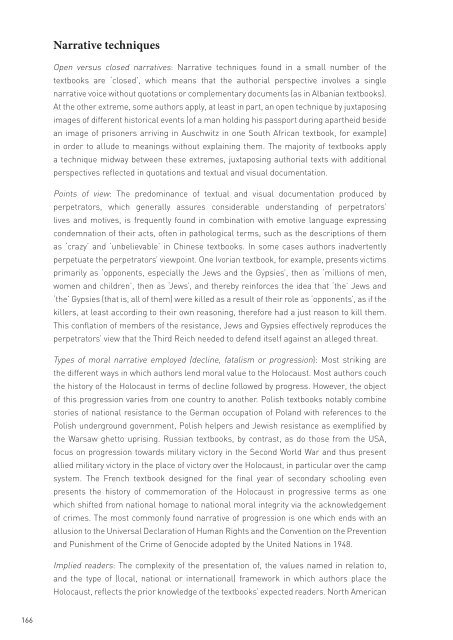228776e
228776e
228776e
You also want an ePaper? Increase the reach of your titles
YUMPU automatically turns print PDFs into web optimized ePapers that Google loves.
Narrative techniques<br />
Open versus closed narratives: Narrative techniques found in a small number of the<br />
textbooks are ‘closed’, which means that the authorial perspective involves a single<br />
narrative voice without quotations or complementary documents (as in Albanian textbooks).<br />
At the other extreme, some authors apply, at least in part, an open technique by juxtaposing<br />
images of different historical events (of a man holding his passport during apartheid beside<br />
an image of prisoners arriving in Auschwitz in one South African textbook, for example)<br />
in order to allude to meanings without explaining them. The majority of textbooks apply<br />
a technique midway between these extremes, juxtaposing authorial texts with additional<br />
perspectives reflected in quotations and textual and visual documentation.<br />
Points of view: The predominance of textual and visual documentation produced by<br />
perpetrators, which generally assures considerable understanding of perpetrators’<br />
lives and motives, is frequently found in combination with emotive language expressing<br />
condemnation of their acts, often in pathological terms, such as the descriptions of them<br />
as ‘crazy’ and ‘unbelievable’ in Chinese textbooks. In some cases authors inadvertently<br />
perpetuate the perpetrators’ viewpoint. One Ivorian textbook, for example, presents victims<br />
primarily as ‘opponents, especially the Jews and the Gypsies’, then as ‘millions of men,<br />
women and children’, then as ‘Jews’, and thereby reinforces the idea that ‘the’ Jews and<br />
‘the’ Gypsies (that is, all of them) were killed as a result of their role as ‘opponents’, as if the<br />
killers, at least according to their own reasoning, therefore had a just reason to kill them.<br />
This conflation of members of the resistance, Jews and Gypsies effectively reproduces the<br />
perpetrators’ view that the Third Reich needed to defend itself against an alleged threat.<br />
Types of moral narrative employed (decline, fatalism or progression): Most striking are<br />
the different ways in which authors lend moral value to the Holocaust. Most authors couch<br />
the history of the Holocaust in terms of decline followed by progress. However, the object<br />
of this progression varies from one country to another. Polish textbooks notably combine<br />
stories of national resistance to the German occupation of Poland with references to the<br />
Polish underground government, Polish helpers and Jewish resistance as exemplified by<br />
the Warsaw ghetto uprising. Russian textbooks, by contrast, as do those from the USA,<br />
focus on progression towards military victory in the Second World War and thus present<br />
allied military victory in the place of victory over the Holocaust, in particular over the camp<br />
system. The French textbook designed for the final year of secondary schooling even<br />
presents the history of commemoration of the Holocaust in progressive terms as one<br />
which shifted from national homage to national moral integrity via the acknowledgement<br />
of crimes. The most commonly found narrative of progression is one which ends with an<br />
allusion to the Universal Declaration of Human Rights and the Convention on the Prevention<br />
and Punishment of the Crime of Genocide adopted by the United Nations in 1948.<br />
Implied readers: The complexity of the presentation of, the values named in relation to,<br />
and the type of (local, national or international) framework in which authors place the<br />
Holocaust, reflects the prior knowledge of the textbooks’ expected readers. North American<br />
166




